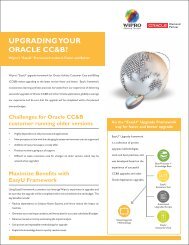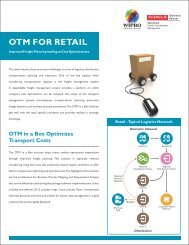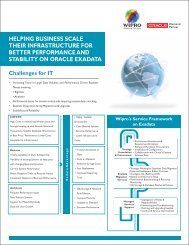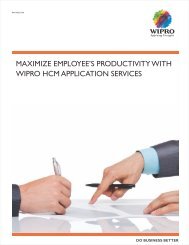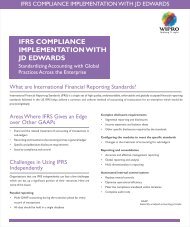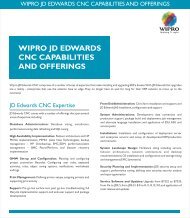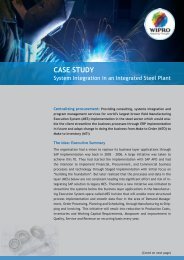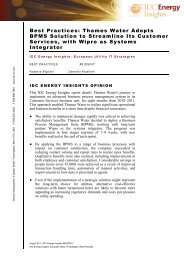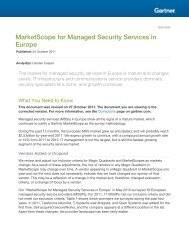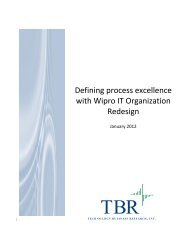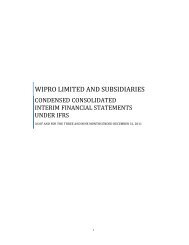Airline Group Revenue Management Analytics
Airline Group Revenue Management Analytics
Airline Group Revenue Management Analytics
You also want an ePaper? Increase the reach of your titles
YUMPU automatically turns print PDFs into web optimized ePapers that Google loves.
CONFIDENTIALITY<br />
<strong>Airline</strong> <strong>Group</strong> <strong>Revenue</strong> <strong>Management</strong> <strong>Analytics</strong><br />
<strong>Airline</strong> <strong>Group</strong> <strong>Revenue</strong> <strong>Management</strong> <strong>Analytics</strong><br />
Whitepaper<br />
Innovated By<br />
27 August, 2009<br />
Authors:<br />
Saktipada Maity (Consultant)<br />
Antony Alex (Business Analyst)<br />
This document is confidential and no reproduction or use thereof is permitted without the consent of<br />
Wipro.<br />
Wipro Confidential 1
<strong>Airline</strong> <strong>Group</strong> <strong>Revenue</strong> <strong>Management</strong> <strong>Analytics</strong><br />
Table of Contents<br />
1 ABSTRACT.......................................................................................................................................................... 3<br />
2 INTRODUCTION ................................................................................................................................................. 4<br />
2.1 GROUP BOOKING PROCESS MAP .................................................................................................................... 5<br />
3 NEED FOR RMS .................................................................................................................................................. 5<br />
4 BUSINESS BENEFITS ......................................................................................................................................... 6<br />
5 PROBLEM DESCRIPTION .................................................................................................................................. 6<br />
6 MODEL FORMULATION ................................................................................................................................... 7<br />
6.1 DEFINITION .................................................................................................................................................... 7<br />
6.2 MATHEMATICAL MODEL ............................................................................................................................ 8<br />
7 SOLUTION APPROACH ................................................................................................................................... 11<br />
7.1 SOLUTION FLOW ......................................................................................................................................... 11<br />
7.2 SOLUTION FEATURES SUMMARY ............................................................................................................ 11<br />
8 HOW WIPRO AT YOUR SERVICE ................................................................................................................... 12<br />
9 APPENDIX ......................................................................................................................................................... 13<br />
Wipro Confidential 2
1 Abstract<br />
<strong>Airline</strong> <strong>Group</strong> <strong>Revenue</strong> <strong>Management</strong> <strong>Analytics</strong><br />
The process of <strong>Revenue</strong> <strong>Management</strong> (RM) for airline industry is currently divided into two<br />
sections on the basis of the Booking Patterns, as <strong>Group</strong> Booking Process (GBoS) and Individual<br />
Booking Process (IBP).<br />
Most airlines today manage group bookings through their specific group booking help desk and<br />
a separate group booking enquiry page on their web site. The entire process involves manual<br />
intervention from both agency and airline side – right from enquiry/ request for group booking<br />
through approval, booking, modifications to the itinerary, payment and ticketing. Travel agents<br />
need to approach airline every time they need any change in group. Complexity of system<br />
interaction between GDS, Booking / Reservation, <strong>Revenue</strong> <strong>Management</strong>, Space Control and<br />
CRS renders it difficult to be manually managed. Entire process is resource-intensive, time-<br />
consuming, error-prone and expensive – right from enquiry to final billing. The turn-around<br />
time from enquiry to acceptance a group request take approximately two to three days. The<br />
problem is further compounded by unfulfilled tasks on PNR resulting in inventory being blocked<br />
which can otherwise be sold at a higher fare thus maximizing the revenue quotient for the<br />
airlines.<br />
Keeping the above factors in mind, Wipro offers an integrated <strong>Revenue</strong> <strong>Management</strong> System<br />
(RMS) that provides decision support for optimal space allocation and pricing of group request<br />
executed using a <strong>Group</strong> Booking Solution (GBoS) as user interface to airline as well as travel<br />
agent. The heart of RMS, the Optimization Engine, will take cues from the existing airline RM<br />
application in effectively managing the group inventory using advanced optimization<br />
techniques. This is done with respect to analyzing historical data of group bookings, identifying<br />
the bid price control (MAF: Minimum Acceptable Fare), agency’s group booking activities<br />
(bookings, revenue accounted, actions on PNR, cancellations and no-shows) and also analyzing<br />
utilization rates of the group bookings and many more.<br />
In industry, various products are available in the market in the form of <strong>Group</strong> Booking and<br />
<strong>Revenue</strong> <strong>Management</strong> applications which work in conjunction as a group booking solution for<br />
the airlines. Both differ from the e-booking portal, GBoS which Wipro offers in terms of<br />
extensive features that airlines can make use of. Extensive backlogs of manual requests being<br />
queued in the application, labored analysis of the agency itinerary requests, complex decision<br />
makings are some of the issues attributes to the existing solutions in the market. Inclusion of<br />
Optimization Engine (heart of RMS) will make the solution complete, offering end-end booking<br />
backed by strong analytics with the ability to provide results on a real-time basis thus reducing<br />
the manual intervention associated with the <strong>Group</strong> Booking process.<br />
The conceptual paper mainly addresses the RMS, GBoS features, Optimization Engine Modeling<br />
and Solution Approaches.<br />
Wipro Confidential 3
2 Introduction<br />
<strong>Airline</strong> <strong>Group</strong> <strong>Revenue</strong> <strong>Management</strong> <strong>Analytics</strong><br />
The major difference between a group and a normal booking is the passenger count of the<br />
requested itinerary. As defined by the airlines, any availability requests for ten or more<br />
passengers will be classified as group space request. The next major difference between the<br />
two is the time frame over which they are received. The individual bookings are not realized<br />
until 8 weeks prior to the departure, group requests are routinely received as many as eight to<br />
nine months prior or may be even more. The reason why group bookings are committed at a<br />
reasonable period prior to departure is that the inventory being allocated as ‘group booked<br />
space’ if released due to cancellations or group reductions at a later data, say close to<br />
departure may not find enough demand hence increasing the sunk costs for the airlines.<br />
There are two primary steps of group booking process: Ah-hoc and Series.<br />
Ad-hoc requests are made for one specific group flying on a specific itinerary. Typically, travel<br />
agents or tour operators will make ad-hoc requests to an airline after receiving the request<br />
from the third party or they may request a group of seats on speculation, based on anticipated<br />
demand.<br />
Series request on the other hand is long term in nature, involving many groups traveling on<br />
many dates. Typical requests of this kind is made by the cruise lines, military and tour<br />
wholesalers who book similar itineraries over several weeks rather than individually. We will<br />
have very less opportunities to improve group revenue for contract request. So, we would<br />
generally concentrate on the Ad-hoc booking process.<br />
Three important parameters that characterize the Ad-hoc <strong>Group</strong> Booking Process are:<br />
• Number of group request<br />
• Size of group request<br />
• Utilization rate<br />
The gamut of <strong>Group</strong> <strong>Revenue</strong> <strong>Management</strong> Problem can be divided into various segments for<br />
optimized decision support of <strong>Airline</strong> <strong>Revenue</strong> <strong>Management</strong> Analyst:<br />
• <strong>Group</strong> Size Allocation problem<br />
• <strong>Group</strong> Pricing<br />
• Discount Allocation<br />
• Overbooking<br />
Keeping the above requirements in mind, Wipro offers an integrated <strong>Group</strong> <strong>Revenue</strong><br />
<strong>Management</strong> System (RMS) that provides decision support for optimal pricing of group request<br />
automatically using a <strong>Group</strong> Booking Portal (GBoS) as a user interface to airline as well as<br />
travel agent. The heart of RMS, the Optimization Engine, will take cues from the existing airline<br />
RM application in effectively managing the group inventory using advanced optimization<br />
techniques.<br />
The main objectives of <strong>Revenue</strong> <strong>Management</strong> System (RMS) with respect to <strong>Group</strong> Booking<br />
are:<br />
• To build RMS functionalities around the core areas like <strong>Group</strong> Booking, Discount<br />
Allocation, Overbooking, Pricing and categorizing a Travel<br />
• Reduced manual intervention by automating the computations around the analysis.<br />
• To build mathematical models around RMS that will collect data from the <strong>Group</strong> Booking<br />
portal and airline revenue management system.<br />
Wipro Confidential 4
2.1 <strong>Group</strong> Booking Process Map<br />
<strong>Airline</strong> <strong>Group</strong> <strong>Revenue</strong> <strong>Management</strong> <strong>Analytics</strong><br />
Based on understanding by Wipro, collated and prepared by the Domain team<br />
3 Need for RMS in <strong>Group</strong> Booking<br />
<strong>Revenue</strong> <strong>Management</strong> <strong>Analytics</strong> uses sophisticated procedures balancing supply and demand to<br />
maximize revenue and profit for the airline. <strong>Revenue</strong> <strong>Management</strong> has generated billions of<br />
dollars for airlines, hotels, car rentals, cruise lines, retailers and manufacturers. RMS is mainly<br />
concerned with the demand management decisions and the methodology and the systems<br />
required to support the process. RMS supports in reality supports three crucial decisions. They<br />
are:<br />
§ Capacity Control decision - Much of relevance here in the airline industry as the capacity<br />
(or the seat inventory) is perishable. Deciding on the point whether to accept the offer;<br />
Wipro Confidential 5
<strong>Airline</strong> <strong>Group</strong> <strong>Revenue</strong> <strong>Management</strong> <strong>Analytics</strong><br />
how to allocate capacity across different segments; when to withhold selling but offer<br />
them at a later point of time<br />
§ Pricing decision – Mainly used as a lever to control the revenue. Pricing differentiation<br />
across product categories; Special prices arranged on mutually agreed terms; Individual<br />
prices; Discounted pricing for the patronisers are some of the few<br />
§ Marketing and Sale decisions – Selling format to be adopted based on market timings<br />
and the type of audience; Terms of trade that can be put on offer; Segmentation and<br />
Positioning the products and services e.g. Bundling<br />
4 Business Benefits<br />
Utilizing the RMS, Clients expect to experience significant improvements in revenue and<br />
customer service, coupled with booking efficiency and reduced manual intervention.<br />
RMS will remove the need for manually looking into the itineraries selected by the end<br />
users (agency users) for analysis and decision making by the revenue team. Enables to<br />
accurately estimate demand based on the current booking trend.<br />
Models will analyze the requests online and provide real-time results thus reducing the<br />
overall turnaround time.<br />
Optimizes the revenue management operation for group booking with the sole objective<br />
of increasing the revenues.<br />
Reduces the number of empty seats that fly for an airline on the day of departure by<br />
using the concept of overbooking, which helps to increase the revenue.<br />
To provide extensive features that supports the decision making of the airlines backed<br />
by strong analytics.<br />
5 Problem Description<br />
Most airlines today manage group bookings through their specific group booking help desk and<br />
a separate group booking enquiry page on their web site. The decision on accepting the request<br />
(anticipating the likelihood of utilization of the requested group space), calculation of the price<br />
ensuring the value (price) arrived at breaches the displacement/opportunity cost had the same<br />
inventory been allocated for a future request, discounted value to be computed for special<br />
travel products can be complex based on the number of requests, cancellation and travel<br />
agencies. The entire process involves manual intervention from the airline revenue department<br />
rendering the whole process a tedious and error prone.<br />
Instead we can conceptualize an optimal group revenue management system that takes<br />
care of:<br />
1. Provides an optimal airline seat allocation scheme to travel agents or tour operators for<br />
their group booking requests.<br />
a. Number of seats for group booking process<br />
b. Number of group bookings request<br />
c. Size of each group booking request<br />
d. <strong>Group</strong> Price per seat<br />
e. Refundable deposits<br />
Wipro Confidential 6
<strong>Airline</strong> <strong>Group</strong> <strong>Revenue</strong> <strong>Management</strong> <strong>Analytics</strong><br />
2. Provides an optimal control mechanism on group booking process<br />
a. Demand pattern<br />
b. Booking pattern<br />
c. Cancellation pattern<br />
d. “No Show” pattern<br />
e. Overbooking<br />
f. <strong>Group</strong> booking start date<br />
g. <strong>Group</strong> booking end date<br />
h. Time between negotiation phase and placement of non-refundable deposits<br />
i. Time between non-refundable deposits and actual purchase of tickets<br />
j. Time between actual purchase of tickets and day of departure<br />
Thus from the above discussion it is quite clear that the RMS comprises of different modules of<br />
separate problems which are to be addressed in a structured manner to come to a reasonably<br />
good solution.<br />
6 Model Formulation<br />
6.1 Definition<br />
<strong>Group</strong> booking process generally starts about twelve months prior to the flight departure. Let<br />
the time span from the start of the booking to the actual flight departure be divided into<br />
suitable intervals as T = t, t-1…1,0. Where, t=0 denotes that the flight has actually departed.<br />
For each time points we have the demand for the seats, average fare for the seats and the<br />
actual request that comes for the group booking. To illustrate further consider the following:<br />
t=T, diT<br />
FiT, µiTr<br />
Let,<br />
The Set be defined as:<br />
I = Class of fares for an airline.<br />
K= the total time interval starting from the start of group booking till the departure of the flight<br />
Let the Variables be defined as<br />
At each time point there are three components to group booking process:<br />
dij = Demand that is estimated from the historical data at the time point ‘j’ for the ‘i’th class.<br />
Fij = Average fare that is to be estimated from the historical data at time point ‘j’ for class ‘i’.<br />
µijr = the group request that comes at the time point ‘j’ for the class ‘i’.<br />
Ci = the number of reserved seats for group booking for the class ‘i’.<br />
g<br />
∑ =<br />
Ci<br />
t=j, dij<br />
Fij, µijr<br />
Thus i 1 = C, where C= total seats reserved for group booking process and ‘g’ denotes the<br />
total booking class.<br />
Wipro Confidential 7<br />
t=T, di0<br />
Fi0, µi0r
g = the number of class that an aircraft has.<br />
<strong>Airline</strong> <strong>Group</strong> <strong>Revenue</strong> <strong>Management</strong> <strong>Analytics</strong><br />
Fik = denotes the average fare for the i th class at a particular time interval ‘k’ for the i th class.<br />
C = the group booking limit for the i th class.<br />
C1kr = Opportunity cost to the airline when the traveler books for a certain number of seats but<br />
pays the advance for a fraction of it.<br />
P1kr= Fraction of originally booked tickets at k th time point.<br />
C2kr = Opportunity cost to the airline when the traveler does not pay for all the seats for which<br />
advance was paid.<br />
P2kr = Fraction of the un-purchased seats at k th time point.<br />
C3kr = Opportunity cost to the airline for the seats which are purchased but the passenger does<br />
not show up.<br />
P3kr = Fraction of the tickets actually purchased kth time point.<br />
Decision Variable:<br />
xikr denotes the number of seats that will be allotted to a request (r) of size µikr at time point<br />
‘k’.<br />
Here we are assuming that a group request of µ at a particular time point comes for the i th<br />
class.<br />
6.2 Mathematical Model<br />
The base model that would be used for optimization can be given as:<br />
Z = MAX∑ r<br />
Subject to<br />
∑ k<br />
g<br />
{(∑<br />
i=<br />
1<br />
Fik<br />
xik<br />
xikr
<strong>Airline</strong> <strong>Group</strong> <strong>Revenue</strong> <strong>Management</strong> <strong>Analytics</strong><br />
Model output of P gives the group size. Solving the objective function of (P) gives the maximum<br />
revenue that can be earned at k th point of time where k K.<br />
Minimum Acceptable Fare (MAF) Calculation<br />
In accepting a group request of size ‘S’, an airline potentially displaces upto S individual<br />
passengers. Since group fares are often discounted below the individual passenger fares in the<br />
same booking class, the decision of whether or not to accept a group request is directly<br />
dependent on individual passenger demand for each flight leg in the group’s itinerary. The<br />
group request should be accepted as long as the revenue generated from the group is greater<br />
than the expected revenue of the individual passengers the group displaces. This is generally<br />
termed as the Total Expected <strong>Revenue</strong> of Displaced Passengers (TERDP).<br />
Minimum Acceptable Fare (MAF) = TERDP/ (<strong>Group</strong> request size)<br />
Where TERDP is calculated using the Network Based Displacement Cost Model.<br />
Let us define Z(C) to be optimal objective value function (I) using the initial set of group<br />
booking limit C.<br />
Now consider an ad hoc group request size S.<br />
Define Z(C-S) to be optimal objective function solving (I) where the capacity constraints of<br />
each aircraft where the group will travel is decreased by the size request S.<br />
The value Z(C-S) is the best solution to the problem given that one has accepted the group<br />
request and S seats are no longer available for further passenger booking.<br />
We define the difference of the objective functions Z(C) and Z(C-S) to be D(S) which is defined<br />
as TERDP. Thus D(S) represents total expected revenue of displaced passengers. In<br />
algorithmic form the following can be proposed:<br />
Step 1: Find Z(C) using the linear mathematical programming formulation (P) for the given<br />
network.<br />
Step2: Reformulate the mathematical program to calculate Z(C-S), where the capacity<br />
constraints used in step 1 reduced by S where the group travels. The reformulated model is<br />
given as:<br />
Z = MAX {(∑<br />
i=<br />
Subject to<br />
g<br />
1<br />
Fikxik<br />
xik
Step3: Find D(S) = Z(C) – Z(C-S).<br />
Step4: MAF = D(S)/S.<br />
<strong>Airline</strong> <strong>Group</strong> <strong>Revenue</strong> <strong>Management</strong> <strong>Analytics</strong><br />
The steps are to be executed in a looping procedure where the next starting point would be<br />
Z(C-S). The procedure would continue till all the seats are used up or group request period<br />
ceases whichever may be early.<br />
Discounted Allocation<br />
As described in the introductory phase the airlines may be interested to allow discounts to<br />
agencies to attract more bookings and thus increase the revenue. The discounts are allowed for<br />
the agencies that have good reputation in the market. Thus the airlines may be interested to<br />
estimate the reputation of an agency based on some factors which are listed as:<br />
1. Payment history: This denotes how timely the travel agents pay their dues be it the non<br />
refundable amount or the actual payment of the fare.<br />
2. Proportion of bookings: This factor actually denotes the proportion of the seats that the<br />
traveler buys to the total number of seats they actually commit to buy.<br />
3. Market reputation: This forms an important guideline for the airlines to provide discounts<br />
especially to the agents which are not regular customers for the particular airline. Good<br />
market reputation would often be a driving factor to provide discounts.<br />
4. Familiarity of the agents: this is also a driving factor for the airlines to provide discounts.<br />
Agents who are regularly book tickets from a particular airline are more likely to get better<br />
discounts and offers.<br />
Keeping the above factors a “score” can be generated for each agent that books tickets from<br />
the particular airline. This score would guide the airlines to provide discounts and offers on the<br />
“MAF” which is calculated using TERDP. The scoring is done using a Multiple Logistic regression<br />
model, which is an extension of the Logistic regression with more than one covariate. The<br />
decision variables are generally qualitative variables which would be the scoring variable in our<br />
case.<br />
Overbooking<br />
In group booking scenario cancellations and “no shows” are quite common. This results in few<br />
of the flight seats to fly empty. Thus the airline authorities would like to keep the provision of<br />
booking excess to the capacity in order to maximize the revenue and reduce the number of<br />
seats that actually fly empty. A point to note here is that aggressive overbooking might result<br />
in more passengers than the physical capacity at the time of departure. Such a situation leads<br />
to passengers being denied boarding a flight.<br />
Thus an overbooking factor should be calculated. Let as mentioned number of seats allotted for<br />
group booking be ‘C’.<br />
Over booking factor (OF) = 1/ (1-NS)<br />
Where NS = Average no-show rate.<br />
As described in (I) and aggregate of p1, p2 and p3 would give an estimate of Utilization factor<br />
say ‘u’. Thus compliment of ‘u’ would give an estimate of the NS.<br />
Wipro Confidential 10
<strong>Airline</strong> <strong>Group</strong> <strong>Revenue</strong> <strong>Management</strong> <strong>Analytics</strong><br />
Thus OF*C gives the number of overbooking group seats.<br />
To start of initially the estimates of p1, p2 and p3 are to be calculated using the historical data.<br />
7 Solution Approach<br />
7.1 Solution Flow<br />
7.2 Solution Features summary<br />
S. No Factors Description Drivers<br />
1 Determining the<br />
MAF<br />
3 Discounted Fares Discounted percentage<br />
determination to be applied<br />
on fares<br />
i)MAF for a given O&D, Date Displacement cost<br />
calculation, <strong>Revenue</strong><br />
optimization and Inventory<br />
<strong>Management</strong><br />
ii)Extending MAF for multileg<br />
journey<br />
iii)Self-adjustable MAF due<br />
to nearing departure time<br />
/cancellations/increased<br />
demand<br />
Customer loyalty<br />
management<br />
Wipro Confidential 11
<strong>Airline</strong> <strong>Group</strong> <strong>Revenue</strong> <strong>Management</strong> <strong>Analytics</strong><br />
Estimating discounts to be<br />
based on product type<br />
(Leisure/Student/Corporate)<br />
and on agency performance<br />
4 Re-routing Requests that cannot be<br />
accommodated can be rerouted<br />
for an alternative<br />
date<br />
e.g. +/- one day to the<br />
departure date (determine<br />
off-peak periods from<br />
historical data)<br />
5 Auto-split i)System will split the group<br />
count across itineraries<br />
ii)Computing the number of<br />
passengers to be split<br />
across itineraries<br />
6 Utilization Rates To be computed for a given<br />
O&D, date , itinerary,<br />
agency, season etc.<br />
7 Overbooking Determine % of<br />
overbooking level and<br />
encourage booking in case<br />
of anticipated group space<br />
cancellations from the<br />
Agents<br />
8 How Wipro at your Service<br />
Wipro Confidential 12<br />
Nearing departure time/nonavailability/<br />
higher<br />
displacement cost<br />
Customer loyalty ensured<br />
that no group space requests<br />
are rejected on the basis of<br />
group counts<br />
Track agency performance,<br />
revising demand when for a<br />
given O&D and date<br />
utilization rates change<br />
across group bookings<br />
previously made<br />
Reduces Unsold Inventory<br />
Wipro is primarily an IT services company. In its continuous effort to be innovative and<br />
productive we have also built a number of Product frameworks, re-usable components, tools<br />
and IPs for the benefit of our clients. This is a part of our effort to reduce our clients total cost<br />
of ownership of the product/service and enhance our domain skills around our clients’ industry.<br />
This is as a part of several Centers of Excellence (COE) created where-in dedicated teams work<br />
on building frameworks for the benefit of our clients. Following this we have developed the<br />
Booking Engine framework interfaced directly with the CRS for Flight Booking, <strong>Group</strong> Booking<br />
and <strong>Airline</strong> ancillary solution. Our intent is to communicate that Wipro is not a product company<br />
where-in we derive our revenue from software product sales, but an IT services company which<br />
brings value to the client by building and using our re-usable frameworks and components
<strong>Airline</strong> <strong>Group</strong> <strong>Revenue</strong> <strong>Management</strong> <strong>Analytics</strong><br />
Wipro Delivers<br />
1. Across industries especially the airline sector, IT faces renewed pressure from business to<br />
prove their value and it is vital for any partners to understand that the true value they must<br />
produce is business value, not technology value. Wipro, as a transformational outsourcing<br />
partner, works with out clients to help focus their technology initiatives on the critical<br />
business drivers and objectives, while consistently driving toward value based business<br />
solutions.<br />
2. Wipro provides significant thought leadership in the effective use of both transformational<br />
outsourcing and IT as business value engines. In addition to the cost reduction benefits,<br />
our vast experience as a leader in outsourcing enables us to provide our customers with<br />
cross-functional process improvements, business process insights, system standardization,<br />
system documentation, and delivery of operational excellence across managed platforms<br />
9 Appendix – definitions<br />
Overbooking – Accepting more reservations than the actual capacity of the airline. This is<br />
used as a hedge against likely cancellations from the passengers.<br />
MAF - Any fare above the MAF is likely to have a negative displacement cost i.e. the fare that is<br />
accepted by the airline can more than offset the likelihood of selling the same in the future<br />
<strong>Group</strong> Booking – As per airline terminology any requests for booking with the count of<br />
passengers exceeding 10 or above is classified as a group space request<br />
Utilization Rate – It is the ratio of the Actual arrivals for departure to the initial <strong>Group</strong> Space<br />
blocked<br />
Class of Service – The accommodation of passengers at different fare levels is achieved by<br />
specifying it through a Fare Class<br />
Feeders – A subset of the whole lot travelling from a different destination to the group origin<br />
point. <strong>Airline</strong>s cater this special group booking service through ‘Feeders’<br />
No-shows – A person reserved on a flight neither travels or cancels the reservation made<br />
PNR – Passenger Name Record is a unique identifier held in the Computerized Reservation<br />
System containing the itinerary of an individual or a group of passengers<br />
Wipro Confidential 13




